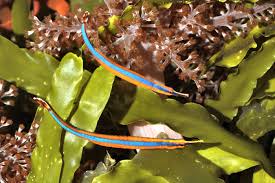ANIMAL: Bluestripe Pipefish Doryrhampus excisus Type of Animal: Pipefish Habitat: Reefs, reef crevices, tidepools, lagoons, coral gutters Location(s): Indo-Pacific & tropical/subtropical Pacific Appearance: Pipe-like body, orange to reddish body w/ signature bluish mid-lateral stripe, maroon to red fan-like tail w/ variable markings, elongated snout, females have smoother snouts while males have more hooky bumped snouts Food/Diet: Cyclops, mysid shrimp, brine shrimp, copepods, copepod eggs, fish eggs, zooplankton, fish parasites Status in Wild: Stable Conservation: Breeding in aquariums, aquaculture, & zoos. Captive breeding reducing demand for wild-caught fish. Lifestyle: Male-female pairs Additional Info: Called: Male: Seastallion Female: Seamare Young: Fry Group: Pair Height: Adult: 2.7 in Young: 0.7 in Gestation: 3 weeks Life Span: 5-10 years Body Length: Adult: 2.7 in Young: 0.7 in Snout Length: 0.9 in Tail Length: 1.5 in Main predators are brain corals, fish, crabs, & large shrimp. Adults will eat fry. Males are territorial & sometimes fight to the death. Females also fight fiercely. These fish are in the same family as seahorses. Also called Blue-and-Orange Cleaner Pipefish, Flagtail Pipefish, Pacific Blue-Stripe Pipefish, & Black-Sided Pipefish. These fish engage in mutualistic relationships w/ larger fish in which they inspect for parasites, w/ the pipefish getting a meal & the client fish having less parasite. Pairs often have cleaning stations. Prior to spawning, pairs engage in elaborate courtship dances. During spawning, females deposit eggs into male’s breeding pouch. After 3 weeks, male gives birth to 40-150 fry. Most active at dawn & dusk (crepuscular). Advertise presence to potential clients by bobbing up & down & swimming in waving motion. While stable, potential threats such as over-collection for aquarium trade, medicine trade, & use as souvenirs loom. These are very peaceful fish. Coloration becomes more heightened during courtship. When fry hatch, they’re free-swimming. Use tube-like snout to ingest food. These fish are very shy & secretive in the wild & in captivity. They rely on sight to feed. Fun Fact(s): They can move their eyes independently. These are not the easiest fish to keep & are best left for expert aquarists.
